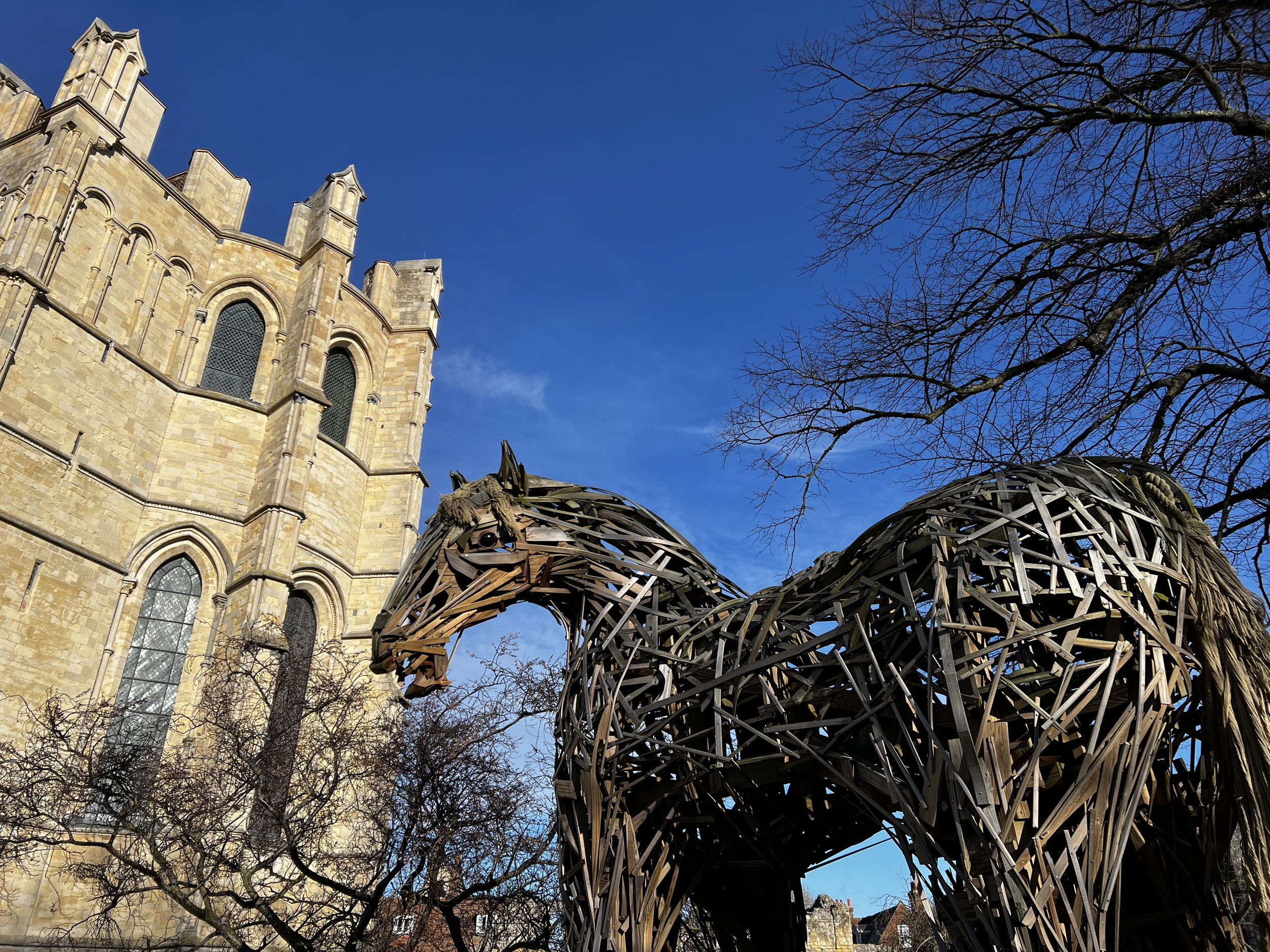Tales From Canterbury
“If all the swords in England were pointed against my head, your threats would not move me. I am ready to die for my Lord that in my blood the Church may obtain liberty and peace.”
Surveying Canterbury Cathedral it’s difficult to imagine it does not even make the top 10 of largest cathedrals in the world.
It does hold the distinction of being England’s oldest cathedral however. St Augustine arrived in Kent in AD 597 and quickly established the first church site on English soil at the present-day site of Canterbury Cathedral.
Looking up into the Southwest Spire.
Canterbury Cathedral is the Mother Church of the worldwide Anglican Communion, seat of the Archbishop of Canterbury, a UNESCO World Heritage Site, and the resting place of royalty and saints.
Throne from the Chapel of Edward the Confessor, one of the last Anglo-Saxon English kings, he ruled from 1042 to 1066. He was deposed by the Norman king William the Conquer. A nearly thousand-year-old relic!
Amnesty International Candle.
Steps leading up to the Trinity Chapel at the very front of the Cathedral (this is where the Shire stood, as you’ll read below).
Of all the tales from Canterbury, the story of Thomas Becket is certainly the most famous.
Becket was friends with Henry, who became King Henry II of England in 1154 and made Becket his Chancellor.
Both labored tirelessly to bring law and order to Henry’s realm. It was during Henry’s reign that the legal term “trial by jury” became familiar in the English language, as the king’s judges travelled the country administering the common law—the law of all free men. The exception to this was the Church, which had its own courts and own laws.
On the death of his Archbishop of Canterbury in May 1161, Henry saw his chance of bringing the Church to heel, by promoting his best friend Thomas to the newly vacated post.
With the donning of his archbishop’s robes however, Becket’s whole demeanour seems to have changed, as he appeared to have experienced a religious conversion.
King Henry and Becket remained good friends until they clashed over clerical privilege. Henry stated that the church was subject to the law of the land, but Becket insisted that the Church was above the law.
Their confrontation came to a head at Northampton Castle in October 1164, when supporters of Henry questioned Becket’s loyalty to his king by accusing him of being a “Traitor.”
Thomas spent some six years in exile before things calmed down sufficiently for him to return to Canterbury. Preaching from the cathedral on Christmas Day 1170, Thomas again displayed his stormy temperament when he excommunicated some of his fellow bishops with the words, “May they all be damned by Jesus Christ!”
Henry became incensed when he heard of this outburst and is said to have uttered the fateful words, “Will no one rid me of this turbulent priest!”
Four of Henry’s knights, probably not the brightest of men, took this as a summons to action, and left for Canterbury immediately.
“I'd like Frank Shirley, my boss, right here tonight. I want him brought from his happy holiday slumber over there on Melody Lane with all the other rich people, and I want him brought right here! With a big ribbon on his head!”
- Clark Griswold
They reached Canterbury Cathedral on December 29th, where they found Becket before the High Altar, as he had gone there to hear Vespers. One of the knights approached him, and struck Becket on the shoulder with the flat of his sword. It seems that the knights did not at first intend to kill Becket, but as he stood firm after the first blow, the four attacked and butchered him. It is recorded that they cracked open his skull spilling his brains onto the cathedral floor!
Henry was horrified when he heard the news as he believed that it was his words that had been the cause of Becket’s death. As an act of penitence he donned sackcloth and ashes, and starved himself for three days.
Becket was immediately hailed as a martyr and canonised in 1173, after which his shrine in Canterbury Cathedral became the most important center of pilgrimage in England, with relics associated with him distributed to churches throughout Europe.
Behind Will and Amanda a candle burns in the Trinity Chapel at the front of the Cathedral to mark the spot where the Shrine of St Thomas of Canterbury stood from 1220 to 1538—the shrine so many made a pilgrimage to visit.
The candle marking the place of the Shrine (above)—its heavy lid being raised to allow pilgrims a glimpse of the gem-encrusted casket containing his remains.
The beautiful ceiling above where the Shrine once stood.
Unfortunately this shrine was totally destroyed during the Reformation in 1540, when King Henry VIII ordered his bones to be destroyed and all mention of his names obliterated.
Today, the place of Thomas’s murder in Canterbury Cathedral is marked by a simple stone bearing his name (below).
Altar of the Sword's Point—the sculpture by Giles Blomfield represents the knights' four swords that killed Becket (two metal swords with reddened tips and their two shadows). It is named after the blade of the sword that killed Becket, which broke due to the force of the final blow.
The Northwest Transept—the scene of Thomas Becket's murder on December 29, 1170. The fine stained-glass northwest window dating from 1482 depicts Edward IV and his family at prayer.
Statue of Geoffrey Chaucer on High Street in Canterbury
The Canterbury Tales is a collection of twenty-four stories written by Geoffrey Chaucer between 1387 and 1400. The tales are presented as part of a story-telling contest by a group of pilgrims as they travel together from London to Canterbury to visit the shrine of Saint Thomas Becket at Canterbury Cathedral. The prize for this contest is a free meal at the Tabard Inn at Southwark on their return.
The Tabard Inn was established in 1307 and stood on Borough High Street, at the road's intersection with the ancient thoroughfare to Canterbury. It was famous for accommodating people who made the pilgrimage to the Shrine of Saint Thomas Becket at Canterbury Cathedral.
Stained glass window of St Thomas Becket.
Entering the crypt.
A new (though far less grand) shrine to St Thomas Becket in the cathedral’s crypt.
Check out this tomb from the crypt. You may notice that the head of every carving has been removed. This was done by Henry VIII’s men during the Reformation started in 1534.
In the crypt.
King William Everett of Paso Robles.
The choir screen with its magnificent stone work, decorated with angels carrying shields and the crowned figures of six monarchs: Henry V, Richard II, Ethelbert of Kent, Edward the Confessor, Henry IV, and Henry VI.
The choir screen on the left and the magnificent view up into the spire. Just look at the detail all the way up in the top ceiling.
Standing in the choir looking up into the spire. Magnificent!
The pulpit in the Choir.
The Canterbury War Horse—represents the over eight million horses that died during the First World War, of which many travelled through Kent on their way to the continent. The memorial honors loss of human and animal life without being overly literal, and is presented with dignity, its head bowed in respect and solemnity in this place of quiet contemplation, reflection, and remembrance.
Wild-looking tree.
The cloisters
The Christchurch Gate off Buttermarket Court leading to the Cathedral grounds.
A cool door the passes through the Christchurch Gate.
Will in Buttermarket Court.
Canterbury Cathedral beautifully illuminated at night.
The spires are striking in the nighttime sky.



































